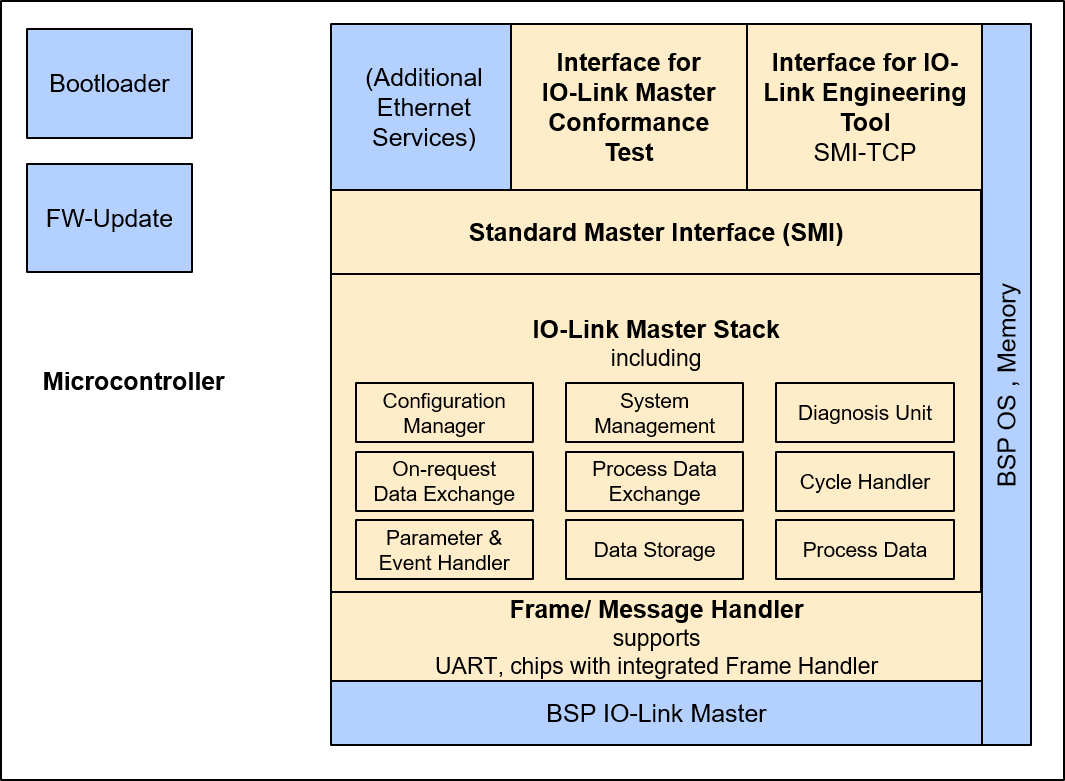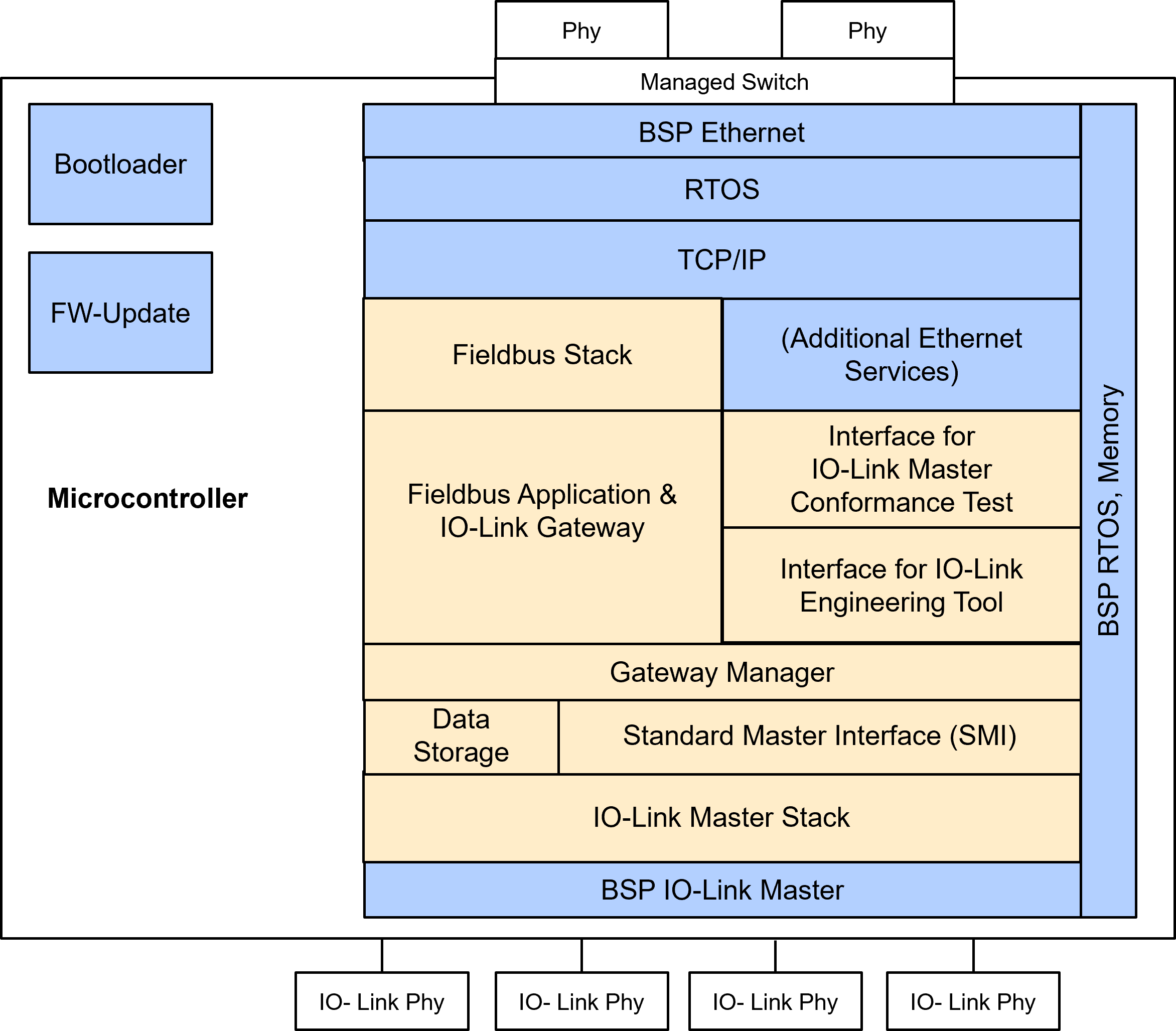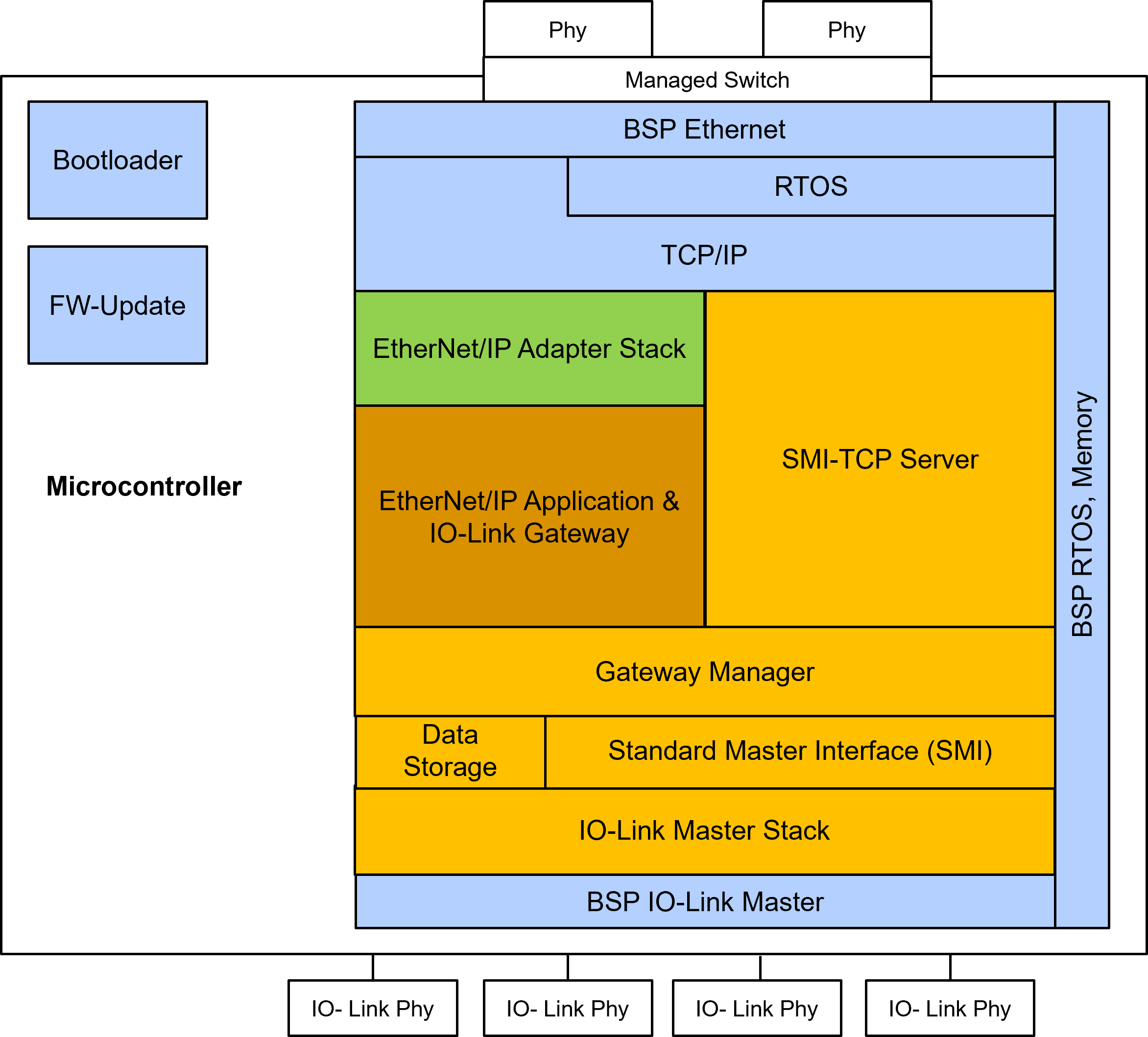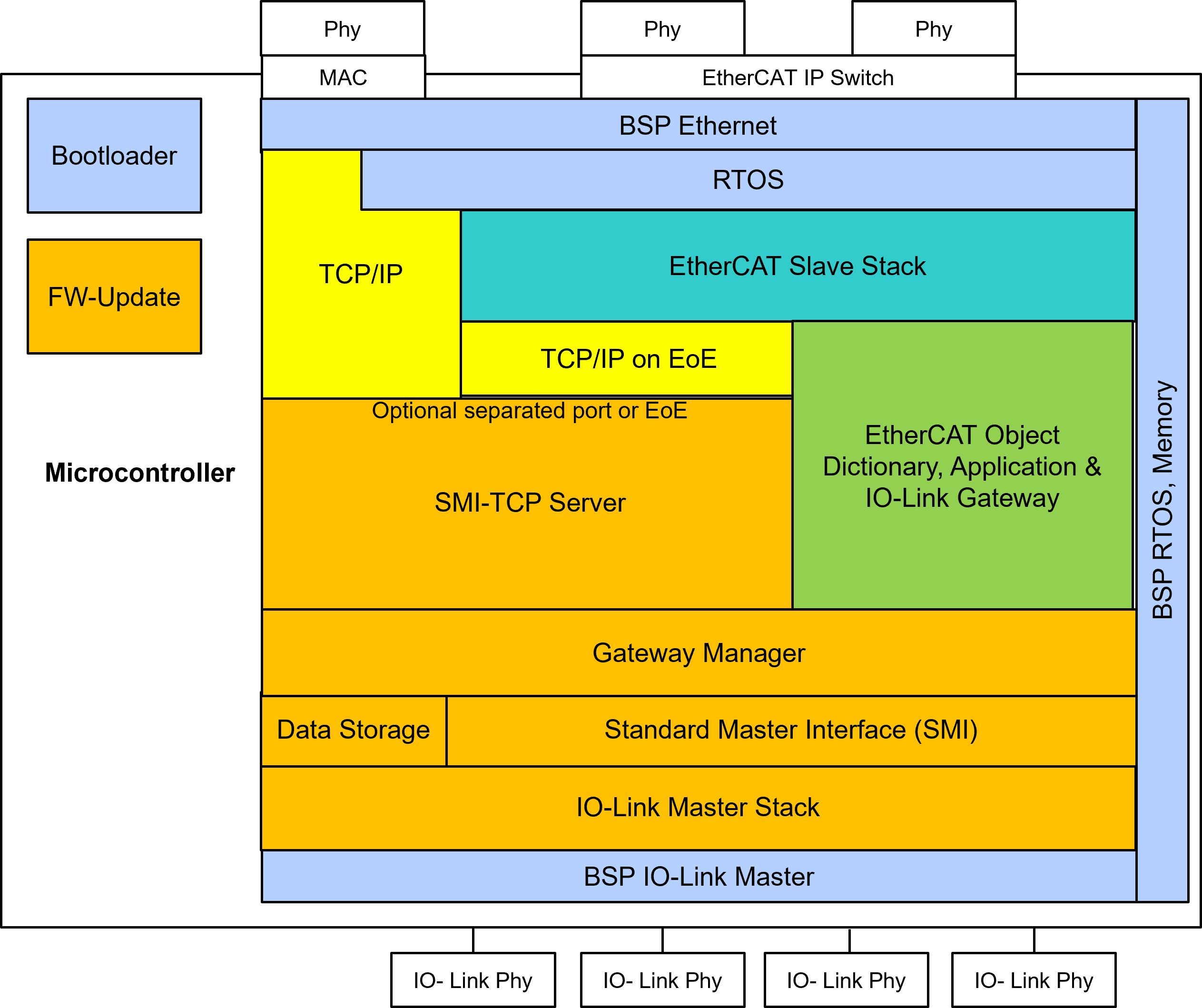IO-Link Master Software
Our IO-Link master software has the widest distribution worldwide and can be used for a wide range of architectures. In addition to the portable universal solution, we offer our in-design solution. Here, the IO-Link master is implemented on a separate microcontroller that communicates with a host controller via a serial interface. The solution comes with schematic, ready-to-use firmware, host driver source code as well as test report. This solution gives you the shortest time to market.
IO-Link Master Software V3


On the one hand, we offer our IO-Link Master Software V3. This consists of the communication stack, frame/message handler, standard master interface (SMI) and an interface for connecting the IO-Link master conformance test and for connecting an IO-Link engineering tool.
Only the hardware adaptation (Board Support Package), the internal communication of the system, the connection to the master test system and the memory handling for non-volatile data have to be implemented device-specific. We can gladly take care of this for you within a project as well.
IO-Link Master Stack
Our IO-Link master stack is designed to be highly portable and is already used on many platforms such as Renesas V850, Rx, 78K0R, R32, RZ/N, ST microelectronics STM32 Cortex M3, M4 and H7, microchip PIC 32, ATMEL ATSAM4, Infineon XE165 / 167, Cypress-Fujitsu 16FX, Xilinx MicroBlaze, Altera NIOS 2, NXP LPC1700 / 1800, TI Sitara, AMIC and others.
Standardized Master Interface (SMI)
The "Standardized Master Interface" (SMI) was specified for the first time in the IO-Link specification (V1.1.3; Jun19), is mandatory and is intended to facilitate integration into higher-level systems as well as the IO-Link master test.
The application interface (API) of the new version 3 of the TMG TE IO-Link Master software follows this specification.
Frame/ Message Handler
IO-Link is a half-duplex serial communication. In principle, only one level converter is required per port as a line driver (transceiver) and one UART in the microcontroller. In order to bundle several channels and to be able to offer multi-port drivers, there are transceivers with a so-called frame handler. Here several UARTs are integrated in the transceiver and the connection to the microcontroller is made via SPI.
- Use of the microcontroller's UART with the IO-Link phy as a pure level converter
- IIn this operating mode, the frame handler of the TMG-IO-Link master stack is used
- IO-Link frames are established by the microcontroller and sent/received via the UART of the controller
- Verwendung eines in der IO-Link-Phy enthaltenen Framehandlers
- In this mode, the MicroController talks to the Phy via SPI and this contains the frame handler and UARTs.
- This has the advantage that the microcontroller needs less serial interfaces
With few ports (e.g. 2) UART is simpler and better performing. With several ports, the solution via UART often fails due to the number of available UART interfaces in the microcontroller. In addition, the time behavior of the solution with frame handler is somewhat less critical.
The TMG IO-Link master stack supports transceivers with and without frame handler. For the transceivers with frame handler from Maxim and Dialog corresponding modules are integrated in the stack. Only the UART or SPI driver must be implemented in the Board Support Package.
IO-Link Master device description (IOLM) and IOLM-Checker
There is a device description (IOLM) for the integration of IO-Link masters in the IO-Link Device Tool V5.1 - PE. Similar to the IODD, there is a checker tool. The specification for the IOLM and the IOLM checker is also part of the scope of delivery.
TMG Protocol SMI-TCP
With the new version 3 of our IO-Link Master software we deliver the communication stack for the SMI-TCP protocol from TMG TE. This serves both the connection to the IO-Link Device Tool V5.1, the IO-Link Master Test and can also be used for the communication to Edge Gateways.
The SMI-TCP is characterized by:
- High robustness for heavy-duty network or radio operation
- Support of modular systems
- Compliant with the Standardized Master Interface (SMI)
- Vendor-specific master functionality possible
- Identification of header station and modules
- Multiple connections possible
- IO-Link Device Tool V5.1 and IT communication simultaneously
- Edge-Gateway Connections
- Industry 4.0 applications
Theoretically, fieldbus communication, OPC UA or IO-Link JSON could also be used to connect an engineering tool. However, the lack of functionality, complexity, footprint and performance speak against this.
TMG Test Adapter SMI-TCP
To be able to use the IO-Link master test system without integrating a specific protocol only for the test, we have developed the TMG Test Adapter SMI-TCP, which adapts the test protocol of the IO-Link master test system to SMI-TCP as a Windows 10 application.
- complies with IO-Link specification V1.1.4
- contains the Standard Master Interface (SMI)
- Supports all IO-Link master functions and telegram types
- Data Storage (Parameter Server)
- All bitrates (230.4, 38.4, 4.8 Kbit)
- 400μs cycle time at 230kBit/s
- can operate IO-Link version 1.0 devices
- The number of ports depends only on the μC-resources
- is easy to port to different microcontroller platforms
- can be used with all IO-Link transceivers. There are interfaces specifically for frame handler operation with transceivers such as those from Dialog or Maxim.
- Consistent separation of communication stack and hardware adaptation
- the communication stack does not need to be changed for porting to different platforms
- does not require an operating system
- Example: ARM M7, 32bit, compiler setting: optimized
- Flash: 24 Kbyte
- RAM: 1,5 Kbyte
- Additional RAM per port: approx. 1,6 Kbyte data + 2Kbyte data storage →3,6 Kbyte
- Example: Master with 4 ports: 1,5 + 4 * 3,6= 15,9 Kbyte →ca. 16 Kbyte
- Source code in ANSI-C
- PDF documentation
- The hardware customization is supplied as a template and must be adapted in each case
IO-Link Master
In-Design Solution V3
 On the other hand we offer a very comfortable In-Design Solution with ready-to-use firmware. For this we provide the circuit diagram of our IO-Link master module so that it can be integrated into your devices. If the circuit diagram is implemented exactly, our firmware can be used unchanged. In this case, the IO-Link master is implemented on a separate microcontroller, which communicates with a host controller via a serial interface. For this solution we also provide the protocol test report, which can be referred to in the manufacturer's declaration. This solution allows the shortest time to market.
On the other hand we offer a very comfortable In-Design Solution with ready-to-use firmware. For this we provide the circuit diagram of our IO-Link master module so that it can be integrated into your devices. If the circuit diagram is implemented exactly, our firmware can be used unchanged. In this case, the IO-Link master is implemented on a separate microcontroller, which communicates with a host controller via a serial interface. For this solution we also provide the protocol test report, which can be referred to in the manufacturer's declaration. This solution allows the shortest time to market.
A circuit diagram is supplied for the hardware with microcontroller, transceiver and EEPROM for the IO-Link master functionality as well as the matching firmware. The firmware can be used unchanged. It is supplied as executable code and consists of the IO-Link master software and a bootloader for updating the IO-Link master software.
The IO-Link master controller is connected to its host controller via a serial interface (SPI) via which the firmware update can also take place. TMG TE develops and tests the software on a hardware based on the supplied schematic and provides a protocol test report with each new firmware version. This can be referenced in the manufacturer's declaration. Of course, this is only possible if the schematic and the firmware were used unchanged. Therefore the firmware is delivered as executable code. For the host controller, the driver is available as source code. This can easily be adapted to the respective platform.
As with the IO-Link master stack (for any platform), we supply the protocol stack for the SMI-TCP for integration in the IO-Link Device Tool V5.1. For the creation of the then necessary master device description (IOLM), both the specification, the XML schema and the IOLM checker are included in the scope of delivery.
- Use as a "black box"
- We deliver executable code. All protocol tests are performed according to test specification
- TMG TE's test report can be referenced for the manufacturer's declaration
- If required, the source code can be purchased additionally
- Firmware consists of:
- IO-Link Master Firmware
- TMG IO-Link Master Stack
- Addressing the non-volatile memory e.g. for Data Storage
- IO-Link master application , mapping of the IO-Link master functionality to the SPI communication to the host controller
- SPI communication to host controller
- Operating additional digital IO channels
- Board Support Package
- Bootloader
- Firmware update of the IO-Link master functionality via SPI
- Host controller software
- Host Library and SMI-TCP Stack
- Separation of logic and hardware adaptation
- Easily portable to many platforms
- Microcontroller used: STM32F4 or STM32G4
- Transceiver used: Analog Devices/Maxim MAX14819A
- Scalable from 2 to 8 ports
- Documentation as PDF
- Bootloader Image + IO-Link Master Firmware Image for Programming in Production
- IO-Link master firmware image for update via SPI
- Host controller software
- Host Library
- Source code in ANSI-C
- is easy to port to different microcontroller platforms
- SMI-TCP Stack: Portable C source code
- Hardware schematic and parts list
IO-Link Gateway Applications


Based on our basic technology like the Master Stack or also the PROFINET IO Device Stack as well as EtherNet/IP Adapter Stack we can offer you corresponding IO-Link Gateway Applications as an option package.
The figure shows the basic architecture. It describes all relevant elements of the firmware. Partially the elements are available as TMG product (license). Other elements we have realized in many projects, but are not available as product/license, because they have been customized. Therefore we can provide a suitable offer after clarification of the requirements. The same applies to the Board Support Package (BSP): For some platforms we have already realized this, but this is always platform and hardware specific.
RTOS and TCP/IP as well as e.g. SNMP should be available for the hardware platform or must be ported. Often open source can be used, but also commercial software.
The following IO-Link gateways are available:
- TTechnical specifications
Implementation of PROFINET IO-Link integration according to the latest specification: - IO-Link-Integration-for-PROFINET_Ed2_2832_dV11_Oct19
- Scope of delivery
- Source code in ANSI-C
- PDF documentation
- EDS file


- Scope of delivery
- Source code in ANSI-C
- PDF documentation
- EDS file


- Scope of delivery
- Source code in ANSI-C
- PDF documentation
- ESI file


